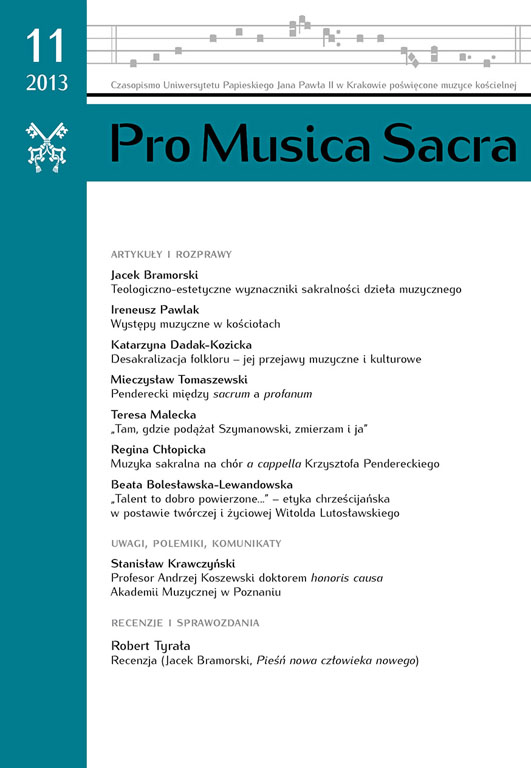Występy muzyczne w kościołach
DOI:
https://doi.org/10.15633/pms.554Słowa kluczowe:
budynek kościoła, występy muzyczne, koncert, repertuar, wykonawcy, słuchaczeAbstrakt
Music in churches performed outside the liturgy had already appeared in the Middle Ages. However, the Church was always considered the place to praise God, so the repertoire was adapted to the seriousness of a sacral building. In the course of time, this sense of sacrum started to diminish, which has become particularly visible since the Baroque period and has been continuing to this day. The contemporary liberalism has brought to the music, among others, conceptual relativism. It is characterised by setting new meaning to the concepts which had not raised doubts until now. For example, an “artist” – a performer who has little in common with artistry. The same problem refers to a “concert”, as every performance is commonly accepted, even the one that is average, as giving a concert. The documents of the Catholic Church clearly demand that music which is basically secular ought not to be brought to churches. Apart from that, there are also requirements as to the repertoire, involving instruments, the performers’ behaviour and audience during musical performances in churches. The idea is that the nature of the music itself and the atmosphere connected with it should reflect the seriousness of the place of performance and are conducive to the act of spiritual building of the gathered followers, deepening their devotion, not so much on the aesthetic level as on the religious one. In such a way the Church has been defending against the weakness of faith and shows the right way for the glory of God.Pobrania
Opublikowane
2013-12-30
Numer
Dział
Artykuły i rozprawy
Licencja
Prawa autorskie (c) 2013 Ireneusz Pawlak

Utwór dostępny jest na licencji Creative Commons Uznanie autorstwa 4.0 Międzynarodowe.
Autorzy publikujący w czasopiśmie udzielają jego wydawcy zgody o następującej treści:
- Autor zachowuje autorskie prawa majątkowe do utworu, a jednocześnie udziela wydawcy czasopisma zgody na jego pierwszą publikację w wersji drukowanej i wersji online na licencji Creative Commons Uznanie autorstwa 4.0 Międzynarodowe oraz zgody na wykonywanie opracowań, w tym przekładów.
- Autor ma możliwość udzielania zgody niewyłącznej na opublikowanie utworu w wersji, która ukazała się w czasopiśmie (np. zamieszczenia go w repozytorium instytucjonalnym lub opublikowania w książce), wraz z informacją o jego pierwszej publikacji w czasopiśmie.
- Autor może umieścić swój utwór online (np. w repozytorium instytucjonalnym lub na swojej stronie internetowej) jeszcze przed zgłoszeniem utworu do czasopisma.

